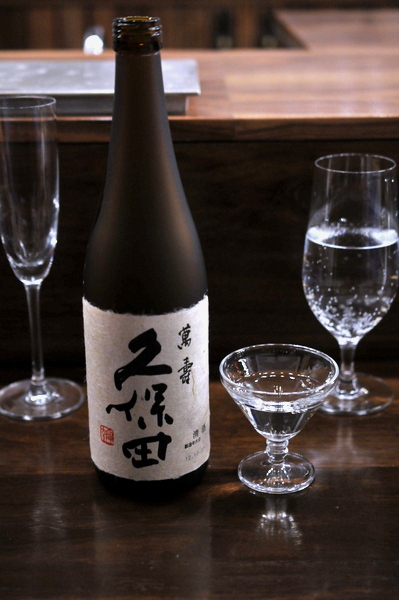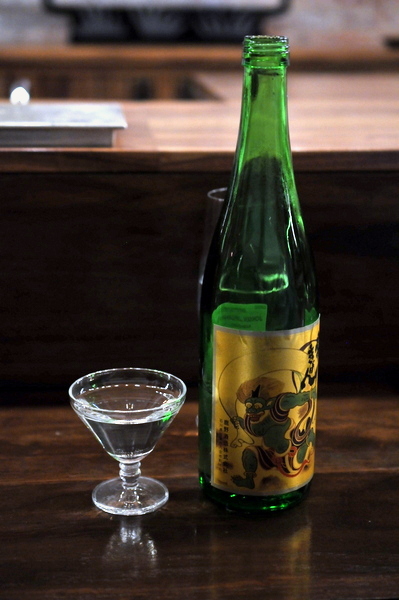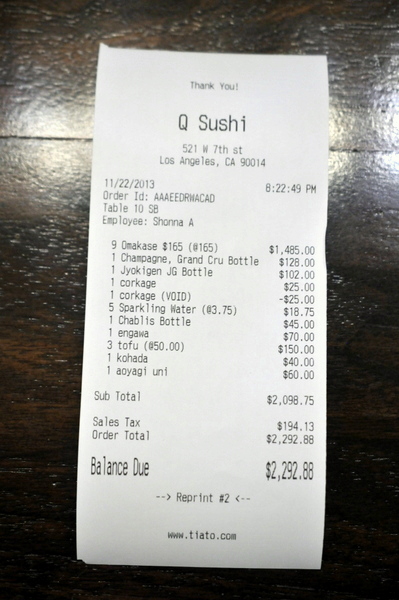San Diego, CA 92130
(858) 314-1900
Despite being California's second largest city San Diego doesn't have much when it comes to fine dining. With little competition in the area, Addison has been racking up awards and recognition since they first opened its doors in 2006. The restaurant is run by Chef William Bradley, the San Diego native first discovered his love for cooking while working as a prep cook during his teenage years. Since then Chef Bradley has spent the lion's share of his career working at hotel restaurants including: the Azzura Point Restaurant in Coronado, Mary Elane's and the Hyatt Regency both in Scottsdale. Bradley has spent the last seven years at Addison where his contemporary French Cuisine is often called the best in the city.
AMUSE: AUTUMN PEAR GAZPACHO - yuzu cremeux
The idea of a pear gazpacho as a starter sounded a bit daunting but it was actually quite refreshing thanks to the light bracing tang of the yuzu cream which balanced the ripe sweetness of the pear.

Bread 01: GOUGERE - sherry, marscarpone
The first of the three breads was a house made Gougere. The cheese puff was a bit larger than most and stuffed with arguably the most delicious filling I've ever had in a Gougere. The sherry and Marscarpone filling is a bit runnier than most but fills the palate with a heady explosion of cheesy savor with a slight vinuous twang.

Bread 02: CROSTINI - lemon, sea salt
This was the most complex of the breads. Dense and a touch chewy, the flavor starts off mild but slowly exudes a citrus-tinged saltiness

01: KUMAMOTO OYSTER - uni, horseradish and lime
Huber - Grüner Veltliner, Obere Steigen, Traisental, Austria 2011
The first official course consisted of two dainty Kumamotos drowned in a creamy horseradish sauce. The sauce adds a lush creamy mouth feel but the horseradish is fairly restrained leaving the uni-augmented saline sweetness of the Kumamotos intact. The accompanying wine was an equally bright affair with intense floral notes, ripe white fruit, and a bright grippy streak of acid.

Bread 03: BRIOCHE - strauss creamery butter
The final bread was a simple dinner roll, warm and flaky the brioche is already infused with a sweet buttery flavor. The butter is actually churned by hand in house and is one of the most flavorful butters that I've ever tasted.

02: SEA SCALLOP - spinach, champagne and caviar
Rene Geoffroy, Brut, Premier, Cru Cumieres, France NV
At the start of the meal I'd asked about extra courses so the staff brought out a plump St. Jacques covered in Golden Oscetra caviar. The duo are a natural pairing, boldly contrasting flavors of sweet and salty bound with an overarching brininess. The champagne sauce and spinach provide a contrasting one-two punch of acidity and bitterness to temper the scallop and caviar. The presentation reminded me of Robuchon's signature scallop dish and though it didn't quite match up even drawing the comparisons speaks volumes about Addison's preparation.

03: CARAMELIZED SABLEFISH - toasted kale, onions and dashi
Domaine Hûet - Vouvray Sec, Loire Valley, France 2011
Sablefish, also known as Black Cod, is one of my favorite cooked fishes thanks to its beautiful flakiness and fatty heft coupled with a slight intrinsic sweetness. The caramelized exterior augments the fish's natural flavor while the charred vegetables add a nuanced bitter counterpoint. The dark onion dashi combined the caramelized sweetness of a French Onion Soup with the umami savor of a dashi and was arguably even more impressive than the fish. The Hûet has an explosive bouquet of tropical fruit with a restraining element of green minerality on the palate.
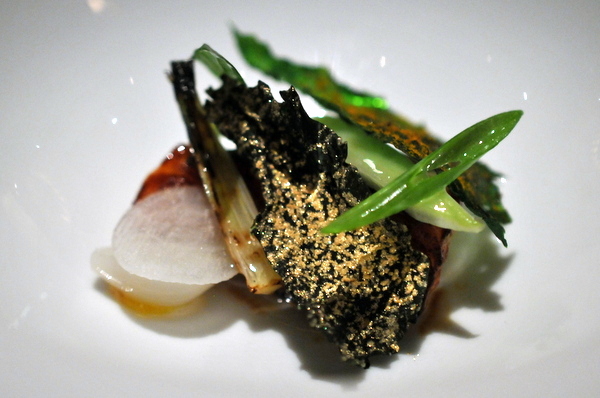
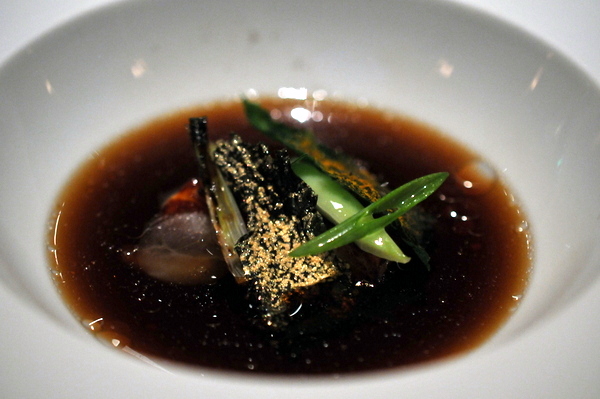
04: SALMON RÔTI «AU BEURRE DOUX» - beets, apples and mustard
Thierry Richoux - Irancy, Burgundy, France 2010
Our second fish course consisted of a beautifully butter roasted salmon. The exterior has a golden brown exterior but the inside is still a translucent raw pink. The raw fish has a touch of fishiness augmented by the mustard an salmon roe. The beets and apple have subtle mix of sweetness and acid, but on the whole the dish feels a bit sparse.

05: FRENCH PUMPKIN VELOUTE - porc pressé, pecans and rosemary
Folk Machine - Valdeguié, Redwood Valley, Mendocino, California 2010
I was a bit surprised when a thick pumpkin veloute was poured over a small bowl of pork and pecan Chantilly cream. I typically find pumpkin a bit on the sweet side but this was nicely restrained. The soup has a soothing autumnal relish that fits the season tempered by the concentrated porcine savor of the pork belly. The accompanying wine is made from a rare grape varietal a ripe spicy red, sweet and lively but with a slight soapy funk.

06: RIS DE VEAU - broccoli, parmesan and white truffles
Giovanni Ross - Nebbiolo, Langhe, Piedmont, Italy 2009
Next up was a huge nugget of rich veal sweetbread. The veal jus was key here bringing forth a dark gamy relish to augment the otherwise monolithic sweetbread. The inclusion of broccoli was a bit puzzling and the oddly muted truffle shavings were a touch disappointing. It's clear the dish has so much potential but it felt like I was only tasting a fraction of the promised flavor.

07: COFFEE ROASTED CANARD - koshihikari rice, candied peanuts and albufera
Bodegas Chacra - Merlot, "Mainqué," Rio Negro, Patagonia, Argentina 2010
The final savory consisted of a roasted duck breast and side of "fried rice." The bird is decently tender but heavy on the nuttiness thanks to the combination of peanut and coffee. In fact the rice overshadows the bird, deftly mixing toasty nuts with a fresh scallion and a savory duck confit.


08: ARTISAN CHEESE COURSE - Acapella, Ardi Gasana, Cabot Clothbound, Largo, Fourme d'Ambert
Fritz Haag - Riesling, Spätlese, Brauneberge Juffer, Mosel, Germany 2006
Addison had five cheeses on offer. The Overall presentation felt a bit bare bones, some honey, preserves or even nut bread would have been a nice addition. First up was the Acapella, a grassy piquant goat's milk cheese from Andante Dairy. The Ardi Gasana was a medium bodied French Sheep's milk. The Cabot Clothbound was my favorite of the quintet, the golden yellow cow's milk cheese was firm, salty, and nutty. The Largo was a second cheese from Soyung Scanlan and Andante Dairy, this a triple cream cheese that has a crumbly texture and earthy mushroom notes. The final cheese was a mild buttery blue cheese from France, creamy and rich with not much of the characteristic blue notes. The accompanying wine was a big sweet Riesling, mango and pineapple, with bright zippy acid and a touch of petrol.

09: SHERBET - cranberry and orange
After the cheeses we were each given a shot glass full of bracing cranberry and orange sherbet as a palate cleanser before the desserts began in earnest.

10: PETITE TARTLETTE - meyer lemon and meringue
Our second dessert was a bite-sized meyer lemon tart, a classic mixture of frothy tart meyer lemon, sugary meringue, and crumbly buttery crust.

11: TARTE AU CHOCOLAT - cherry and pistachio
Kopke - Colheita Port, Portugal 1997
The final dessert was a rich chocolate tart. A thick fudgy layer of rich dark chocolate rests on thin layers of crisp puff pastry. The tarte is paired with classic accompaniments of bright sour cherry and pistachio and two gold flecked chocolate tuilles.

MIGNARDISES - vanilla and chocolate macaron
The final bite of the night was a classic chocolate and vanilla macaron with a touch of raspberry thrown in for good measure.

Addison is generally considered the best restaurant in San Diego and I can see why. The food was thoughtfully designed and flawlessly executed in an opulent dining space and backed up with impeccable if reserved service. At the same time it also has the downsides associated with being a "hotel restaurant." While I wouldn't call the food tired, Chef Bradley and his team definitely play it safe taking few risks and sticking to classic culinary techniques and flavors. More than the food, I took exception with the price; I have no problem paying for food but at $520 per person the experience didn't come close to justifying the cost.

Read more.











